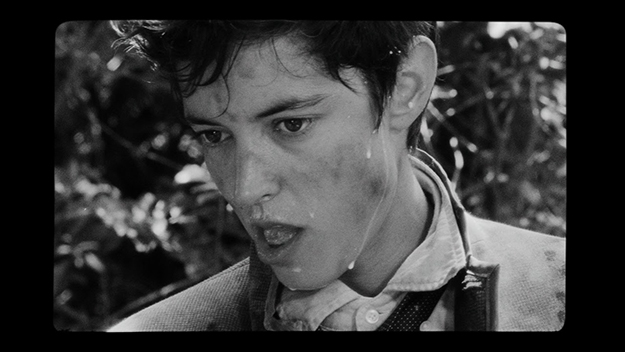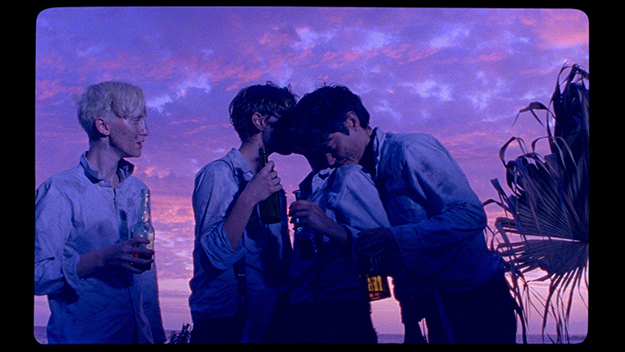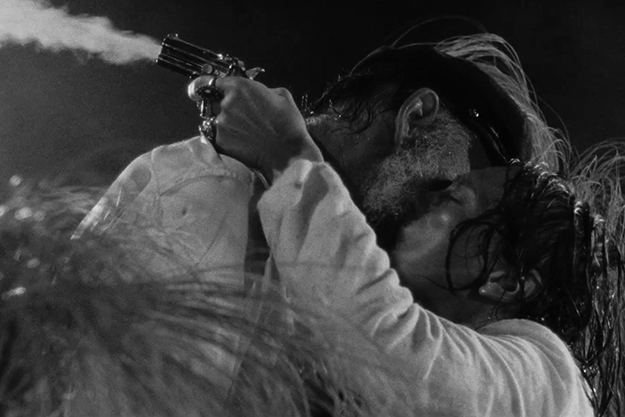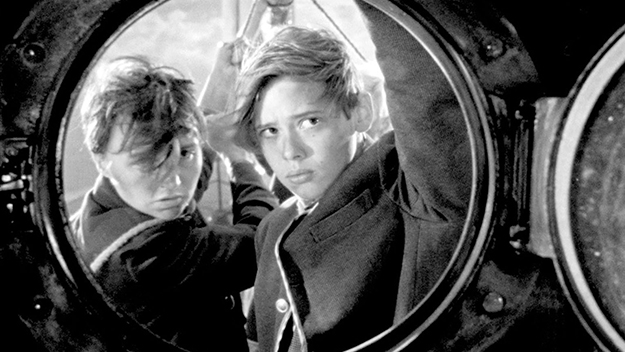In Joris-Karl Huysmans’s Decadent novel of 1884, Against Nature (À Rebours), the aesthete hero des Esseintes cultivates a taste for all that is artificial. One of his particular predilections is for plants that don’t look remotely natural, but appear to have been expressly crafted to look like imitations of plants—with buds that look more like jewels, or leaves that resemble fabric, or better still, rotten flesh pretending to be foliage. This freakish botany comes to mind when watching the new French film Wild Boys (Les Garçons Sauvages), playing in the Film Society of Lincoln Center’s Film Comment Selects series. It was partly shot on the island of Réunion, in the Indian Ocean, and therefore in real tropical forest settings—and yet, director Bertrand Mandico contrives to make you think that he’s actually created this environment on a studio set, and not the most realistic one either. A film of pure artifice, Wild Boys puts you in mind of the work of Guy Maddin (it could all be taking place on a neighboring island to the setting of his notorious short Sissy Boy Slap Party), of Raul Ruiz, and of fellow French directors F.J. Ossang and Yann Gonzalez, director of the torridly pan-erotic You and the Night (he gets a thank-you credit from Mandico). Oh, and let’s add Fassbinder’s Querelle and inevitably Jack Smith too, always an implied guest at this kind of polymorphously perverse dressing-up party. Like much of the work of these directors, Mandico’s film proudly inhabits its own hermetic world and follows its own irreducibly specific codes; we’re talking about the kind of cinema that, unless you take it entirely on its own terms, leaves you thinking, “Yes—but what’s it for?” Unless you’re willing to enter into its erotically facetious dream world, a film like Wild Boys doesn’t make much sense, can look like the work of a filmmaker entirely indulging his own sexual and cinematic fetishes, with complete disdain for whether or not viewers will connect with it. This film represents a particularly elaborate form of snow-globe cinema, creating its own sealed world and inviting you to enter it or just admire it from outside. In literary terms, it’s close to the self-enclosed verbal and imagistic universes of Raymond Roussel and Ronald Firbank, and the end credits thank both William Burroughs and Jules Verne: if those two writers had pitched camp together on some faraway shore, this might be the kind of fantasy that might have jointly concocted.
The wild boys are a group of teenage lads, pupils at some sort of fancy educational establishment. After an eerie nocturnal opening on a tropical island—where one boy, Tanguy, meets a dog with a human face—we meet the wild boys in a flashback: they’re wearing scary papier-mâché rictus masks, and entertaining their literature teacher (Nathalie Richard) by putting on a performance of Macbeth for her. Over-excitable as they are, and in thrall to some sort of demonic deity—which manifests as a jeweled skull and rejoices in the name of Trevor—they rape their teacher and tie her to the back of a horse. A trial follows, in which a long-haired judge rises up in back projection like an avenging deity, and naked gilded men stand guard in the courtroom. Sent home, the boys are pressed into the care of a Dutch sea captain (Sam Louwyck), who prides himself as a specialist in disciplining unruly youth, and pressgangs them into a sea voyage that’s a sort of nautical boot camp. Before they leave, he makes them eat a strange hairy fruit—something between a lychee and a sea urchin, but more ripely laden with sexual overtones than either. On the journey, he uses a bizarre system of ropes and pulleys to keep the boys tied up, making them essentially part of the ship’s mechanism. He also likes to flash his heavily tattooed penis: “If you want something to read, come and see me.” Once at sea, this accursed crew hoist a hairy sail. No, that’s not a euphemism, although in this setting, you’d expect it to be; no, they literally hoist a hairy sail, which is weird enough. Things will get weirder still, me hearties. What I haven’t mentioned yet is the casting of the boys. The Captain taunts one of them by calling him “Fillette” (“Girly” in the subtitles), but the boys are actually all played by women, including the Swinton-esque, severe Anaël Snoek as Tanguy. The best known among the actresses is Vimala Pons as piratical alpha male Jean-Louis, said in the opening voiceover to be “a strange mix of acid and milk.” Pons, one of the most playful and altogether game presences in current French cinema—her credits include Christophe Honoré’s Métamorphoses, Verhoeven’s Elle, and Antonin Peretjatko’s larky The Rendez-Vous of Déja-Vu—looks perfectly boyish here, with a mean scowl, a tough jaw, and the general look of a wolfish teenage Kyle McLachlan (if you want to be really perverse about it, she has the strangest touch of Harry Styles). All the actresses, in fact, look perfectly like boys and for the most part, we forget—if we were ever aware of it—that we’re watching women. This conceptual trick drives the film, and consistently tricks our perceptions, all the more so because these actresses don’t sound remotely female at any point (I couldn’t see any sign in the credits that they were dubbed by males).
The island itself—and heaven knows what the Réunion tourist board will think of this—is a lush erotic paradise. Nutrition is provided by liquid gushing from cactus-like appendages—cue a cascade of blow-job sight gags—while the boys are invited to relax between the foliage-covered legs that writhe in the undergrowth. Designed by Astrid Tonnellier and shot by Pascale Granel—largely in black and white but occasionally slipping into rich, jewel-toned color—the world of Wild Boys is lusciously unreal, its artifice reminiscent of those Maddin films that most resemble fantasy tableaux in department store windows at Christmas. Unlike Maddin, though, Mandico doesn’t revel in the joys of cheapness: Wild Boys looks impossibly expensive at times, sea storm sequences and all, its Sternbergian opulence the polar opposite of the scratchy punk illusionism you might expect from this kind of utterly marginal cinema. Mandico is a new name on me. This is his debut feature, although he has made numerous shorts since 1999, including Boro in the Box, in which Löwensohn—apparently his long-term muse—plays, among other roles, the voice of Walerian Borowczyk. One of his films seems to be an Icelandic tribute to outsider artist Henry Darger, while another is Salammbô, after the febrile Flaubert novel of exotic, erotic antiquity. What can one say about such homages except: it all figures. By the end of Wild Boys, the furry fruits have taken full effect: after an orgiastic scene in which the boys start fighting and kissing in a tempest of white feathers, the actresses finally reveal themselves as women, as breasts fill the screen and prosthetic penises start dropping into the sand left, right and center.
If you can manage not to object that we’ve seen it all before—this is not a film that stands on ceremony about originality—Wild Boys is highly pleasurable both as an hyper-crafted aesthetic object and as a sweetly dirty-minded erotic fantasia, polyvalent enough to please all comers (including, presumably, the contingent identified by Blur, “Girls who are boys who like boys to be girls who do boys like they’re girls…”). Wild Boys could almost be a too try-hard entry in a contest to produce the Queerest Film Ever, but it’s engaging and distinctive, although it may fade from your mind like a lurid dream the moment it’s over. The best joke, however, comes at the end, with Dr. Séverin(e)’s last words, “Never be vulgar.” Mandico’s film exists at that delicate nexus that defines a certain school of camp, where outrageous vulgarity shades into the utmost, most exquisite refinement. The makers of Pirates of the Caribbean might want to learn a few tricks to liven up their next installment. Wild Boys screens this Saturday night, February 24, in Film Comment Selects at the Film Society of Lincoln Center. Jonathan Romney is a contributing editor to Film Comment and writes its Film of the Week column. He is a member of the London Film Critics Circle.



